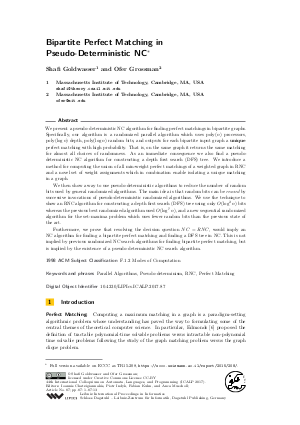Bipartite Perfect Matching in Pseudo-Deterministic NC
Authors Shafi Goldwasser, Ofer Grossman
-
Part of:
Volume:
44th International Colloquium on Automata, Languages, and Programming (ICALP 2017)
Part of: Series: Leibniz International Proceedings in Informatics (LIPIcs)
Part of: Conference: International Colloquium on Automata, Languages, and Programming (ICALP) - License:
 Creative Commons Attribution 3.0 Unported license
Creative Commons Attribution 3.0 Unported license
- Publication Date: 2017-07-07
File

PDF
LIPIcs.ICALP.2017.87.pdf
- Filesize: 0.49 MB
- 13 pages
Document Identifiers
Subject Classification
Keywords
- Parallel Algorithms
- Pseudo-determinism
- RNC
- Perfect Matching
Metrics
- Access Statistics
-
Total Accesses (updated on a weekly basis)
0Document
0Metadata
Abstract
We present a pseudo-deterministic NC algorithm for finding perfect matchings in bipartite graphs. Specifically, our algorithm is a randomized parallel algorithm which uses poly(n) processors, poly(log n) depth, poly(log n) random bits, and outputs for each bipartite input graph a unique perfect matching with high probability. That is, on the same graph it returns the same matching for almost all choices of randomness. As an immediate consequence we also find a pseudo-deterministic NC algorithm for constructing a depth first search (DFS) tree. We introduce a method for computing the union of all min-weight perfect matchings of a weighted graph in RNC and a novel set of weight assignments which in combination enable isolating a unique matching in a graph. We then show a way to use pseudo-deterministic algorithms to reduce the number of random bits used by general randomized algorithms. The main idea is that random bits can be reused by successive invocations of pseudo-deterministic randomized algorithms. We use the technique to show an RNC algorithm for constructing a depth first search (DFS) tree using only O(log^2 n) bits whereas the previous best randomized algorithm used O(log^7 n), and a new sequential randomized algorithm for the set-maxima problem which uses fewer random bits than the previous state of the art. Furthermore, we prove that resolving the decision question NC = RNC, would imply an NC algorithm for finding a bipartite perfect matching and finding a DFS tree in NC. This is not implied by previous randomized NC search algorithms for finding bipartite perfect matching, but is implied by the existence of a pseudo-deterministic NC search algorithm.
Cite As Get BibTex
Shafi Goldwasser and Ofer Grossman. Bipartite Perfect Matching in Pseudo-Deterministic NC. In 44th International Colloquium on Automata, Languages, and Programming (ICALP 2017). Leibniz International Proceedings in Informatics (LIPIcs), Volume 80, pp. 87:1-87:13, Schloss Dagstuhl – Leibniz-Zentrum für Informatik (2017)
https://doi.org/10.4230/LIPIcs.ICALP.2017.87
BibTex
@InProceedings{goldwasser_et_al:LIPIcs.ICALP.2017.87,
author = {Goldwasser, Shafi and Grossman, Ofer},
title = {{Bipartite Perfect Matching in Pseudo-Deterministic NC}},
booktitle = {44th International Colloquium on Automata, Languages, and Programming (ICALP 2017)},
pages = {87:1--87:13},
series = {Leibniz International Proceedings in Informatics (LIPIcs)},
ISBN = {978-3-95977-041-5},
ISSN = {1868-8969},
year = {2017},
volume = {80},
editor = {Chatzigiannakis, Ioannis and Indyk, Piotr and Kuhn, Fabian and Muscholl, Anca},
publisher = {Schloss Dagstuhl -- Leibniz-Zentrum f{\"u}r Informatik},
address = {Dagstuhl, Germany},
URL = {https://drops.dagstuhl.de/entities/document/10.4230/LIPIcs.ICALP.2017.87},
URN = {urn:nbn:de:0030-drops-74824},
doi = {10.4230/LIPIcs.ICALP.2017.87},
annote = {Keywords: Parallel Algorithms, Pseudo-determinism, RNC, Perfect Matching}
}
Author Details
References
-
Alok Aggarwal, Richard J. Anderson, and M.-Y. Kao. Parallel depth-first search in general directed graphs. In Proceedings of the twenty-first annual ACM symposium on Theory of computing, pages 297-308. ACM, 1989.

-
Noga Alon, Shlomo Hoory, and Nathan Linial. The Moore bound for irregular graphs. Graphs and Combinatorics, 18(1):53-57, 2002.

-
Suresh Chari, Pankaj Rohatgi, and Aravind Srinivasan. Randomness-optimal unique element isolation with applications to perfect matching and related problems. SIAM Journal on Computing, 24(5):1036-1050, 1995.

-
Samir Datta, Raghav Kulkarni, and Sambuddha Roy. Deterministically isolating a perfect matching in bipartite planar graphs. Theory of Computing Systems, 47(3):737-757, 2010.

-
Bart de Smit and Hendrik W. Lenstra. Standard models for finite fields. In Handbook of finite fields, Discrete Mathematics and Its Applications. CRC Press, Hoboken, NJ, 2013.

-
Jack Edmonds. Paths, trees, and flowers. Canadian Journal of mathematics, 17(3):449-467, 1965.

- Stephen Fenner, Rohit Gurjar, and Thomas Thierauf. Bipartite perfect matching is in quasi-NC. In Proceedings of the 48th Annual ACM SIGACT Symposium on Theory of Computing, STOC 2016, pages 754-763, New York, NY, USA, 2016. ACM. URL: http://dx.doi.org/10.1145/2897518.2897564.
-
Eran Gat and Shafi Goldwasser. Probabilistic search algorithms with unique answers and their cryptographic applications. In Electronic Colloquium on Computational Complexity (ECCC), volume 18, page 136, 2011.

-
Mohsen Ghaffari. Near-optimal scheduling of distributed algorithms. In Proceedings of the 2015 ACM Symposium on Principles of Distributed Computing, pages 3-12. ACM, 2015.

-
Oded Goldreich. In a world of P= BPP. In Studies in Complexity and Cryptography. Miscellanea on the Interplay between Randomness and Computation, pages 191-232. Springer, 2011.

-
Oded Goldreich, Shafi Goldwasser, and Dana Ron. On the possibilities and limitations of pseudodeterministic algorithms. In Proceedings of the 4th conference on Innovations in Theoretical Computer Science, pages 127-138. ACM, 2013.

- Ofer Grossman. Finding primitive roots pseudo-deterministically. ECCC, 23rd December 2015. URL: http://eccc.hpi-web.de/report/2015/207/.
-
Howard J. Karloff. A Las Vegas RNC algorithm for maximum matching. Combinatorica, 6(4):387-391, 1986.

-
Richard M Karp, Eli Upfal, and Avi Wigderson. Constructing a perfect matching is in random NC. In Proceedings of the seventeenth annual ACM symposium on Theory of computing, pages 22-32. ACM, 1985.

-
László Lovász. On determinants, matchings, and random algorithms. In FCT, volume 79, pages 565-574, 1979.

- Ketan Mulmuley, Umesh V. Vazirani, and Vijay V. Vazirani. Matching is as easy as matrix inversion. Combinatorica, 7(1):105-113, 1987. URL: http://dx.doi.org/10.1007/BF02579206.
-
Maria Serna and Paul Spirakis. Tight RNC approximations to max flow. In STACS 91, pages 118-126. Springer, 1991.

